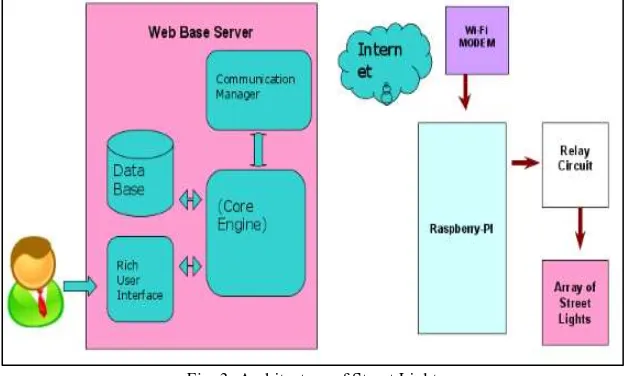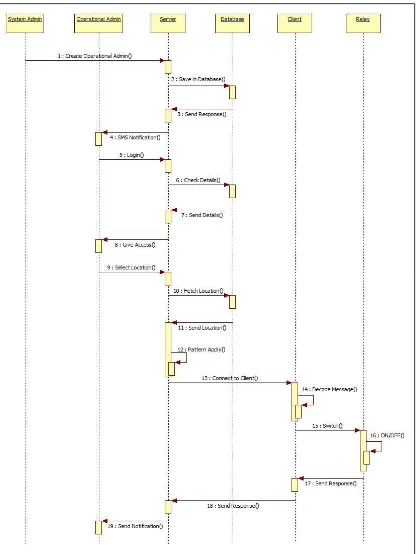Lighting System for Smart Cities
Priyanka Raskar R.M.Samant
NBN Sinhgad School of Engineering, Ambegaon(Bk), Pune- 411041
NBN Sinhgad School of Engineering, Ambegaon(Bk), Pune- 411041
Rani Mote Vaishnavi Patil
NBN Sinhgad School of Engineering, Ambegaon(Bk), Pune- 411041
NBN Sinhgad School of Engineering, Ambegaon(Bk), Pune- 411041
Komal Nighul
NBN Sinhgad School of Engineering, Ambegaon(Bk), Pune- 411041
Abstract
Street Light is essential to ensure comfort and road safety for road user. Street light technology has been improved to more efficient and intelligent. Nevertheless, street light has a problem with energy efficient and cost of system. Street light is one of significant case in electrical consumption for lighting system. Development of street light technology is directed to manage and optimize the system. Management and optimization system are required to solve energy efficiency problem and cost of system problem management is related with remote measurement and control system. So in this system we are using GOOGLE MAP to read graphical user interface and raspberry pi used to monitor energy power. In street light support multiuser system which is system admin and operational admin using this. We switch off or on the light. Street light support the multiple pattern like twp alternative and three alternatives and so on. Sometime street light remain on in the morning is causes wastage of power so we are using automated system.
Keywords: Street Light , Raspberry 3, Power Control, Lighting Control, GSM Module, Genetic Algorithm, renewable energy
________________________________________________________________________________________________________
I. INTRODUCTION
Lighting is one of the most important and expensive responsibility of a city. We know street light installed everywhere in urban area which is needed for pedestrian and vehicle at nighttime. We know that the street light is key factor in any city to make as a smart city. Sometimes street light remain on the morning which causes wastage of light power. also at midnight traffic is not much more at that time street light remain on it causes wastage of power if we want to avoid such type of situation we can make two alternatives or three alternatives. Here we are using raspberry-pi to monitor electrical energy. Smart street light that can work autonomously, save energy and can be seamlessly integrated with exiting grade. The street light in corporate a light emitting diode array and an ARM cortex M0 based microcontroller, both of which are powered by combination of a solar panel and battery pack.
The Internet of Things (IoT) is a recent communication paradigm that envisions a near future, in which the objects of everyday life will be equipped with microcontrollers, transceivers for digital communication, and suitable protocol stacks that will make them able to communicate with one another and with the users, becoming an integral part of the Internet. home automation, industrial automation, medical aids, mobile healthcare, elderly assistance, intelligent energy management and smart grids, automotive, traffic management, and many others. Heterogeneous field of application makes the identification of solutions capable of satisfying the requirements of all possible application scenarios a formidable challenge.
II. FLOWCHART:
Fig. 1: Genetic Algorithm The figure shows the Genetic Algorithm. It has 5 steps
Admin
Admin will login user id and password then it will get the input to user. User Input
User will get the input which is came from admin. Build Message
The system will create message i.e it will give the notification whether it is faulty street light or not set scheduling time like automatic, manual and also select street light pattern e.g. one alternatives, two alternatives, zig-zag.
Send message
Show message which is build then decide whether lamp is on/off. Lamp on/off status
When all process completed then lights are on otherwise light are off. Final Status
If there is no fault in process then lights are on otherwise it goes to the user input.
III. MOTIVATION
We know that street light installed everywhere in urban area which is needed for pedestrian and vehicle. Street light is key factor any city to make as smart city. Sometime street light remain on in the morning which causes wastage of power in era of “global warming” also at midnight traffic is not much more it causes wastage of power
Modes of operation
Auto mode
NO
YES
Admin
User Input
Build Message
Send Message
Lamp On/Off Status
Final Status
Manual mode
It has following four cases: Auto mode
In auto mode, according to the light intensity, slot of times and also monitoring the weather conditions the nodes are being switched on/off. It monitors the complete locality and thus saving power.
Manual mode
In Manual mode, system stores the parameters in computer about changes in environmental conditions continuously like heavy rain visibility, faults ,more or less traffic congestion or during foggy conditions. User can manually define each node with specific intensity factor as per the requirement and can take any suitable corrective measure.
Fig. 2: Four Cases IV. LITERATURE SURVEY
We had studied different papers which are based on smart street light .we conclude that energy waste major issue in our world today. To make the street light alternatives like zig-zag, one alternatives, and two alternatives is solution to the problem of load shading, wastage of power at midnight. IoTcomm Technologies develops communication technologies for the Internet of Things(IoT), including but not limited to Power
Line Communication (PLC), GPRS, and WIFI. By integrating PLC and wireless communication technologies seamlessly, Dotcom has developed an intelligent street lighting control and management system, which provides its customers with the least expensive and the most reliable solution to significantly reduce power consumption. IoT comm also offers power line communication modules and wireless communication modules, which are readily to be integrated into smart automation systems including lighting, and security, access control, or energy monitoring equipment for both commercial and residential buildings. We are serving in the field of street light automation, street light monitoring and controlling and street light management.
The table shows some reference papers that describe smart street light in different ways and technologies Table – 1
Sr
no Title Publication Technical Used Comments
1 Internet of Things for Smart Cities IEEE, 2015
Given IP address to each streetlight and manages those
IP through Cloud
-Very complex design -Huge Infrastructure
needed
2
Remote-Control System of High Efficiency and Intelligent Street Lighting Using a ZigBee Network of Devices and Sensors
IEEE, 2013 Short range ZigBee technique is used for communication
-Range issue -Lot of HW needed for
controlling and monitoring
3
Design and Development of Intelligent Wireless Street Light Control and Monitoring System Along With GUI
IEEE, 2013 WIRELESS ZIGBEE NETWORK
-Range issue -Desktop based
application
4
Optimization of Standalone Street Light System with Consideration of Lighting
Control
IEEE, 2015 only Standalone Street Light System
Can’t be used for switching of arrays of
5
GSM Based Autonomous Street Illumination System for Efficient Power
Management
International Journal of Engineering Trends and
Technology, 2013
Use of GSM (SMS) technique to control streetlights
Network issue of costly GSM modem
per streetlight.
V. PROPOSED SYSTEM
No city can simply switch off its lights at night, so other measures are called for. Not every street and road requires full illumination all the time. Therefore, depending on the site and situation, a frequently feasible option is to dim lights, thereby striking a balance between economical goals and citizens’ safety needs. Dimming lights by up to 50 percent is generally imperceptible to the human eye and can show a 40 percent reduction in power use. Typically, lights would be dimmed during non-peak activity times between 11pm and 5am.
Fig. 3: Architecture of Street Light
With an intelligent streetlight system in place, you will be able to significantly improve the performance, efficiency and reliability of the street lighting in your community. No longer do you need to rely on public complaints and visual inspections after sunset to monitor streetlight function and safety. Through its energy and maintenance reduction capabilities, you will also be able to free up a large allocation of public funds that could then contribute towards other community programs.
Language, Technologies & Platform Requirement:
At least P4 machine with Windows OS loaded Language –Advance Java (J2EE)
JDK 1.7 (Front End) MySql database (Back End) Eclipse 3.4
Tomcat Server 7.0 Raspberry-PI WiFi Dongal Electrical Lamps
Hardware Requirements
2 i-core 3 based machine for development of Server & Client applications. At-least 2 GB RAM
Mouse & Keyboard Raspberry-PI (ARM Board) Lamps
Sequence Diagram
A sequence diagram is an interaction diagram that shows how objects operate with one another and in what order
A sequence diagram shows, as parallel vertical lines (lifelines), different processes or objects that live simultaneously, and, as horizontal arrows, the messages exchanged between them, in the order in which they occur. This allows the specification of simple runtime scenarios in a graphical manner.
The users that have this application installed on their Server and Client communication .According to diagram user needs to submit their valid username and password for login successfully. Client sent request to server then server check the database details according to their client request and finally gives the response for client.
Sequence diagram shows the sequence of the operations being performed by different objects in the system. The above diagram consists of 6 objects and the operations being performed among them
Fig. 5: Component Diagram for View Result
In this system, we are taking different data as input (Longitude, latitude, time). We are using GPS SYSTEM for tracking vehicle, GCM SERVER for transferring data, and GOOGLE MAP to locate the vehicle on particular route. We are using different type of street light like zig- zag, two alternatives, and three alternatives according to traffic. To set the schedule manually and automatically.
VI. CONCLUSION
In this paper, we analyzed the solutions currently available for the implementation of urban internet of things. The system is expected to solve the energy efficiency problem of conventional solar-powered streetlamp system, ensure the traffic safety and prevent crime against nighttime walking. It will also help in making our city as Smart City.
REFERENCES
[1] Jain, Abhilasha, and Chandrasekhar Nagarajan. "Efficient Control Algorithm for a Smart Solar Street Light." Next Generation Mobile Applications, Services and Technologies, 2015 9th International Conference on. IEEE, 2015.
[2] Divya, Guddeti, et al. "Design and Implement of Wireless Sensor Street Light Control and Monitoring Strategy along with GUI." IJITR (2016): 78-81. [3] Novak, Thomas, and Klaus Pollhammer. "Traffic-Adaptive Control of LED-Based Streetlights [Industry Forum] Public lighting in urban environments
accounts for about 50% of the electricity con." IEEE Industrial Electronics Magazine 9.2 (2015): 48-50.
[4] Cheng, Chun-An, et al. "Design and implementation of a single-stage driver for supplying an LED street-lighting module with power factor corrections."IEEE Transactions on Power Electronics 30.2 (2015): 956-966.
[5] H. Schaffers, N. Komninos, M. Pallot, B. Trousse, M. Nilsson, and A. Oliveira, “Smart cities and the future internet: Towards cooperation frameworks for open innovation,” The Future Internet, Lect. Notes Comput.Sci., vol. 6656, pp. 431–446, 2011.
[6] “All India Electricity Statstics,” Central Electricity Authority India, 2010-2011
[7] N. Narendran and L. Deng, “Color Rendering Properties of LEDLight Sources,” SPIE Proceedings, Vol. 4776, 2002




